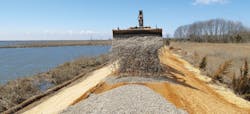About the author:
Tom Knezick is New York branch manager for Pinelands Nursery. Knezick can be reached at [email protected].
On Oct. 29, 2012, the Mid-Atlantic states were subjected to one of the worst storms on record. Superstorm Sandy caused significant tidal flooding throughout the region, and the village of Port Norris in Commercial Township, N.J., was no exception.
Port Norris is nestled along the Delaware Bay in the southwestern portion of the state. Tidal elevations as a result of the storm rose 5 ft above the normal high tides for this area. With the extremely high tides and strong winds associated with the storm, widespread damage occurred to numerous properties. Upland dikes that protect properties from normal tidal inundation were overtopped and damaged by the pounding surf from the Delaware Bay.
Among other flood protection features damaged by the storm was more than a half-mile of upland dike at PSEG Corp.’s Estuary Enhancement Program (EEP) Commercial Township Wetland Restoration Site. In 1997, the EEP restored normal tidal flow to almost 3,000 acres of a previously diked salt hay farm to provide refuge, feeding habitat and nursery grounds for various estuarine animals. Once tidal exchange was successfully restored to the site, native desirable vegetation became established throughout much of the marsh. To protect adjacent properties from normal tidal flooding from the restored marsh, PSEG constructed more than 3 miles of upland dike. The area has been subjected to many storms since the restoration activities were completed almost 16 years ago, and until Superstorm Sandy, the upland dikes remained in good condition. While the dikes performed as designed during the storm, they were overtopped and suffered significant erosion. In addition, the storm tides carried man-made and vegetative debris that cluttered the dikes, and in some cases washed several hundred feet upland of the dikes.
Approximately 80% of the upland dike system at the Commercial Township Restoration Site is adjacent to a restored marsh that is fully vegetated by desirable marsh species. These dikes suffered little to no erosion from Superstorm Sandy, indicating the importance of natural marsh systems. The almost 3,500 ft of dike that were not protected by marsh vegetation, however, were severely damaged and required repairs.
Rebuilding & Repairing
Reconstruction of the damaged dikes began in late November 2012 and was completed in early April 2013. To minimize wetland impacts, the dike repairs were made from the dike crest and within the original footprint. Because the storm tides relocated much of the original dike material, approximately 4,600 cu yd of suitable structural fill were hauled to the site. The dikes were rebuilt to the design elevation, followed by the reconstruction of appropriate side slopes. Where portions of the crest of the upland dikes are frequently used by visitors, more than 20 loads of shell were placed for continued use as a nature trail. To minimize the risk of future erosion, the EEP investigated numerous options to stabilize the side slopes and protect them from the adverse effects of future storms.
Following consultation with Pinelands Nursery, the EEP decided to use a combination of East Coast Erosion Blankets coir logs and coir mats. In total, more than 3,400 ln ft of coir logs were aggressively staked into the dike’s bay-facing side, toed in just above the mean higher high water elevation. The logs are ideal mediums for bank restorations because of their durability, strength and ability for plant colonization. Standard-grade logs are typically 12 ft long with a 12-in. diameter and weigh about 60 lb. Soil was back filled against the base of the logs up to the crest of the dike, then tamped into place. To stabilize the project, more than 29,500 sq ft of 900 gram-per-sq-meter coir mats were pinned down over the fill from the crest of the dike to the top of the coir logs. Traditionally, these mats would be planted with native species, but the EEP chose to evaluate the vegetative regrowth for at least one growing season. In the event the mats do not naturally vegetate, plantings may be performed at a later date where appropriate. The revegetation of these mats has started to take place as many Iva frutescens (high tide bush) and Baccharis halimifolia (groundsel tree) seedlings have started to grow through. It is anticipated that the dike will be completely vegetated in two to three years.
About EEP
PSEG’s EEP was founded in 1994 as a New Jersey Pollutant Discharge Elimination System permit special requirement for the operation of the Salem Nuclear Generating Station. The program has restored, enhanced or preserved more than 20,000 acres of wetlands and adjacent uplands in the Delaware Estuary. In addition to the wetland restoration, PSEG has upgraded fish protection technology at the station’s cooling water intake to increase fish survival, constructed 14 fish ladders for the migration of river herring, and conducts an extensive biological monitoring program for assessing fish abundance and overall program success. In fact, restoration of the diked salt hay farm sites alone contributes to nearly four times the fish biomass that could be adversely affected by the station’s operation. The restoration sites are open to the public and include enhancements such as boardwalks, observation platforms, nature trails and boat launches.
Damage caused by the destructive force of Superstorm Sandy is still visible throughout the area. An observation platform and boardwalk, one of the public use enhancements at this restoration site, remains damaged, with missing boards and bent supports. The dikes, however, are fully repaired and the coir products are installed. Vegetation is returning to the slopes of the dikes. Birds and fish are present in the shallow pools left behind at low tide. It appears that the Commercial Township Restoration Site is back to normal.
Download: Here


